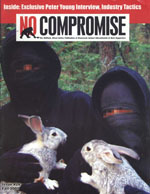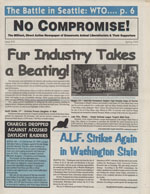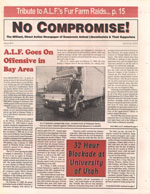Category
No Compromise
-
Most Popular, No Compromise, Periodicals
No Compromise: The Final Two Issues
No Compromise #29-30 (2006. Santa Cruz / San Francisco, CA)
The early days of my activism were so exciting. After a lifetime of feeling powerless I suddenly discovered that there was a community dedicated to fighting the good fight. Its members were in every major city and many smaller ones, and sometimes not living in any city at all, but in trees and encampments. The people involved were empowered to act for themselves in order to create a better world, and had abandoned all the false hope of political parties and their dead politics. Words meant little, action was what counted, and the sky was the limit. The internet was not yet in wide use, and thank goodness! That meant that we met each other in conference rooms, in squats, on the streets, and sometimes on the pages of No Compromise magazine.
No Compromise shaped who I am today. Each new issue contained articles that helped me and thousands of others to evolve our own style of resistance, and as our experience grew we were able to share our stories in the pages of the magazine.
After 30 issues, the steering committee of No Compromise decided to stop publishing in 2006. Their decision could not have come at a worse time. With the SHAC website and newsletter killed by the convictions of the SHAC 7, Bite Back being published only sporadically and with a limited focus, and the Earth First! Journal mired in its “Confronting Oppression Within” drama, the sudden absence of No Compromise meant that the primary sources for radical animal liberation news, opinion, and strategy were the twin sewers of online social networks and the North American Animal Liberation Press Office. These were dark times for our movement, and we are only just beginning to recover.
The final issues of No Compromise were the best of the series, though! I was in prison when issue 30 was released, and it felt electric in my hands. I read it over and over, alternately laughing and crying. As I was putting this post together I decided to pull out that print copy. It gave me the same sense of awe I had when I read those first issues. More than that, it reminded me that there is still a community of people capable of changing the world through compassionate direct action and mutual aid. And you know what? We are going to win!
KEEP FIGHTING,
Josh Harper(The complete set of all past issues of No Compromise can be found HERE)
…
-
No Compromise, Periodicals
No Compromise #27-28
No Compromise #27-28 (2005. Santa Cruz / San Francisco, CA)
The volunteer staff of No Compromise may have only published two issues in 2005, but both were valuable sources of news and ideas from across the globe. As always, the reports inside are bitter sweet. Many animals were rescued, many abusers felt some heat, and many people rose up and fought back. Then, there was the backlash, the senate hearings, and the arrests. The movement has never stopped though, and No Comp always served as a reminder that come hell or high water we were all going to forge ahead, sometimes stronger, sometimes weaker.
One unfortunate development in 2005 was the arrest and conviction of Chris “Dirt” McIntosh. Despite receiving movement support, Chris turned to Nazi groups in prison for advice and friendship. Soon, he counted himself among their ranks, and requested to be removed from animal lib prisoner lists. He would have been removed anyway though: there is never room in our struggle for a Nazi!
Luckily, other prisoners continued to show courage, dignity, and resolve from behind bars. Both 2005 issues of NC contain inspiring letters and interviews with jailed comrades. All in all, this is another must read year for the best animal liberation publication to come out of the United States.
…
-
No Compromise, Periodicals
No Compromise #23-26
02.17.13 | Permalink | Comments Off on No Compromise #23-26No Compromise 23-26 (2004, Santa Cruz / San Francisco, CA)
One of the lessons that archiving old animal liberation publications has taught me is that the most extreme actions have rarely produced much in the way of results for animals. A public that already sees veganism as odd might still see the value of rescuing animals from a laboratory, but will never support a car bombing. When innocents are injured, or when murder was the goal, the backlash starts to creep into our own ranks, and as we fracture law enforcement and industry groups take advantage. In the end, I can think of no bombing (or contamination, or grave robbing, etc.) which advanced the cause of animal rights more than it harmed it. This is not to say that bombings and the like could never be successful. At later stages of many revolutionary struggles, when the majority of the public supports the cause, bombs can clear away in one night what years of protest could not. While a movement is in its infancy, however, it could be argued that more often than not bombs blow up in our faces.
And so it was in 2004 when a group calling itself the Revolutionary Cells Animal Liberation Brigade carried out two bombings of HLS related targets in California. The movement was left to make lemonade from truly shitty lemons, and No Compromise did their best to mitigate the harm of the actions while keeping activists focused on the real enemy.
The year continued with the indictment of the SHAC 7, the emergence of Austria as a leader in the movement, and some exciting open rescues. Sarahjane Blum and Ryan Shapiro’s organization, GourmetCruelty.com, carried out one such operation that piqued public interest and eventually resulted in a sympathetic program on Animal Planet. Elsewhere Gina Lynn was imprisoned for defying the Seattle grand jury, Billy Cottrell was arrested for a massive SUV dealership arson, and the Universtiy of Iowa was treated to the most sophisticated lab raid to occur since the early 90s.
Every time we post a year of No Compromise we say the same thing: that this is essential reading for those who wish to understand the recent history of our movement. This posting is no exception. No Compromise was the best AR publication of its era, and 2004 saw the publication refining its strengths and providing their readers with four of the best issues yet.
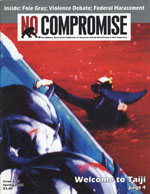



-
No Compromise, Periodicals
No Compromise #20-22
11.15.12 | Permalink | Comments Off on No Compromise #20-22No Compromise #20-22 (2003. Santa Cruz / San Francisco, CA)
No Comp scored another great year in 2003, this time by going deeper into practical instructions for campaigning, and also by examining the smaller stories in greater detail. While the high profile victories of anti-HLS activists were given their due, inspirational figures who had passed on were also given touching coverage. Issue #20 features articles on early Band of Mercy and Animal Liberation Front founder Sue Smith, and Sweden’s animal lib die-hard, Ake Soderlund. Similar examinations of our past, and the courageous figures whose shoulders we stand upon, pepper the 2003 issues. Of particular note is the article on Henry Hutto in issue #21.
2003 was also the year that Rod Coronado finally got off of probation and was allowed to participate in the movement again. His writings for No Compromise were as subversive and inspiring as ever, and it is easy to see why the government considered him such a threat.
As the year progressed No Comp moved to a magazine format and tightened their graphic design skills in response to Jake Conroy’s work on the SHAC USA newsletter. These glossy issues were excellent contributions to the movement, and it is a shame that in only a few more years NC would cease to exist altogether. These information (and inspiration!) packed issues are worth reading again to inform and encourage our current actions.


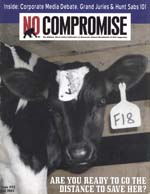
-
No Compromise, Periodicals
No Compromise #18-19
10.23.12 | Permalink | Comments Off on No Compromise #18-19No Compromise #18-19 (2001-2002. Santa Cruz, CA.)
If you have been following our posting of the complete No Compromise than you have read along as the new, 1990s militant grassroots took its first steps, stumbling along an exciting, and at times error filled path towards animal liberation. Those early years saw a lot of dedication and courage, but sadly little in the way of new tactics or intelligent planning.
That all changed in 2001 with the arrival of the anti-HLS campaign in the United States. The focus suddenly shifted from scattershot regional targeting to a single, international pressure point and the results were encouraging.
2001 wasn’t just about the fight against Huntingdon. The tactics developing in that one small struggle were inspiring activists globally to step up the fight against all areas of animal abuse, and sadly, some of our friends ended up in prison as a result. The support of these jailed comrades was inspiring, but our movement was dealt a terrible blow as Barry Horne died on Hungerstrike. That was not the only tragedy we would witness in these 12 months. Jeff Luers was sentenced to nearly 23 years in prison for an act of sabotage which harmed no one. Animal liberationists had been a strong force in the growing movement against globalization of capitalism, and at the 2001 G8 summit we watched as protestors and media were brutalized and bloodied in the lead up to the police murder of Carlo Giuliani. And of course, non-humans continued to be slaughtered in endless, unfathomable numbers. The tone of these two issues of No Compromise may have been optimistic, even cocky, but those of us on the ground knew that times were tough and getting tougher.
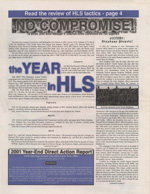

-
No Compromise, Periodicals
No Compromise #15-17
09.01.12 | Permalink | Comments Off on No Compromise #15-17No Compromise #15,16, 17 (2000-2001, Santa Cruz, CA.)
I want to preface this post with this: The turn of the century was an epic time to be alive and fighting! Between the WTO riots, a huge upsurge in ALF attacks on the West Coast, some inspiring support of grand jury resisters, and the migration of the SHAC campaign to the United States, there were also thousands upon thousands of other actions across the planet. It was hard to keep up with all of the news because it seemed that people everywhere had finally taken enough and were beginning a counter strike for non-humans, wilderness, and human freedom. Luckily, No Compromise kept track of most of the action, and produced three excellent issues during this incredible year of revolt. Beyond the coverage of the latest direct actions, attention was also paid to our past successes and failures- and all animal activists would do well to read issue #16’s “Blast From The Past” article about lab raids in the 1980s.
…
-
No Compromise, Periodicals
No Compromise #12-14
05.15.12 | Permalink | Comments Off on No Compromise #12-14No Compromise #12-14 (1999, Old Bridge, NJ and Santa Cruz, CA)
If I had to create a list of my favorite years in animal and earth liberation history, 1999 would be in the top 5. As the movement looked towards the new millennium there seemed to be an intense urgency in the air, perhaps people felt the need to close the 20th century with a bang or leave their mark before the world ended in a technological melt down on Y2K! Whatever the reasons, direct action reached a fever pitch. Lab raids returned to the United States, the Earth Liberation Front continued it’s ascendancy, Hillgrove farm was shut forever, and everyone seemed to be preparing for the World Trade Organization ministerial in Seattle. Across the globe there was a sense that people were not going to take it anymore, and whether you were struggling against bio-technology or prisons or speciesism, chances are good that you were employing some form of illegal tactic.
No Compromise may not have covered everything going on in the global struggle, but if it was animal lib related then chances are it was covered in these three issues. From the death of Alex Slack to end of the annual Hegins pigeon massacre, you’d be hard pressed to find a more complete overview of these twelve action packed months.
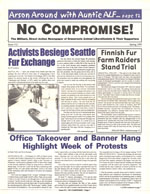
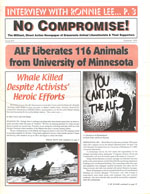
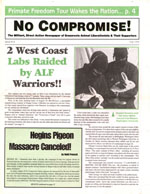
-
No Compromise, Periodicals
No Compromise #9, 10, 11
11.15.11 | Permalink | Comments Off on No Compromise #9, 10, 11No Compromise #9, 10, 11 (1998, Caldwell, NJ.)
After the shakeup caused by Freeman Wicklund’s departure, one might have expected No Compromise to slow it’s publishing schedule while it re-grouped. Instead, they had one of their most productive years, reporting on everything from the first daylight raid in the US, to the murder of Earth First! activist David “Gypsy” Chain. The volume of important articles in these issues is too great to summarize in a tiny blog post, so instead we would just like to encourage you to read each edition thoroughly. Truly, this is one of our favorite posts on Conflict Gypsy so far as it highlights so many significant events in the movement at the end of the 1990s.
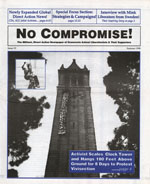
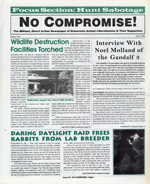

…
-
No Compromise, Periodicals
No Compromise #8 / Strategic Non-Violence for Animal Liberation
10.20.11 | Permalink | Comments Off on No Compromise #8 / Strategic Non-Violence for Animal LiberationNo Compromise #8 / Strategic Non-Violence for Animal Liberation Insert (1997-1998, Minneapolis, MN)
On November 16th 1997, nine years prior to the day that I turned myself in to federal prison in the SHAC 7 case, I was arrested in Anaheim, California. Activists from around the country had descended upon the home of Disneyland to protest the American Association of Laboratory Animal Scientists and we soon found ourselves facing a small army of law enforcement officers. They had miniature tanks, riot suits, pepper spray, batons, counter sniper units on rooftops, and a willingness to use all of the above to maintain the right of vivisectors to keep cutting open living animals. The demonstrations that day set in motion a chain of events that would change the face of grassroots animal rights in America. What does any of this have to do with No Compromise #8 and it’s insert? Allow me to explain.
Freeman Wicklund was a vibrant, young activist from Minnesota. After animal rights militancy had been severely hampered in the late 80’s by grand juries, arrests, and the presence of informants, Freeman was one of the activists who had helped pick up the pieces. His organizing with Student Organization for Animal Rights had made Minneapolis a sort of mecca for direct action oriented vegans, and his projects in the early 90s included traveling to England to bring back literature, documentaries, and interviews about the strengths and weaknesses of the movement abroad. These materials proved to be very influential, and after a short period of contributing to publications such as Out of the Cages, Freeman started No Compromise magazine with a few friends. No Comp, as we called it back then, was the spark that lit a prairie fire. After its publication actions against animal abusers hit a fever pitch.
The 1990s were a complicated time. On the one hand a lot of dedicated, sincere people were taking tremendous risks and making large sacrifices to liberate animals from harm. On the other hand, thrill seekers and status hunters wanted to make a name for themselves while having a little adventure. The epicenter of the latter phenomenon was Salt Lake City. The straight edge scene in Utah was notoriously violent and cultish, and it adherents had attached veganism to their gang-like mentality. Direct actions were on the rise in the area, but many of them were being performed by people who could care less about the politics. When Freeman visited the state in 1997 to help train young people to deal with grand juries, he found a movement based on bragging and scene points. Animals were secondary to climbing the straight edge social ladder, and snitching and self incrimination were epidemic. Disgusted with what he saw there, Freeman began reading the works of pacifist Gene Sharp, and slowly he began to have personal doubts about the role of sabotage and aggressive protest.
Those private conflicts became very public in Anaheim. The AALAS protest drew hundreds of people from multiple states and ended in 8 arrests. While Wicklund was being arrested he began to shout that he was opposed to the ALF at a nearby camera which he mistakenly believed belonged to news media. (The camera was being operated by the police to gather evidence against the protestors.) While we were being detained in the Orange County Jail he told the other arrestees that he was a pacifist now, and upon his release he announced via e-mail lists that he would be quitting his job as editor at No Compromise. When issue #8 was released it contained an editorial announcing his departure, along with a 16 page insert that detailed the focal points of his new strategy.
The supposed “violence vs pacifism” debate is unlikely to ever be resolved, but the contentious battles between the two sides of that argument can sure tear apart a movement. Freeman, for his part, was not content to simply let his views be known. His actions now provide us with a clear road map of what not to do with tactical dogmatism; he began traveling the country denouncing direct action at conferences, he sent out press releases denouncing ALF actions, he even went so far as to visit and disrupt meetings of pro-direct action organizations, including Student Organization for Animal Rights, the group he once worked for.
Many people who had been inspired by Freeman now could not decide where they stood and slowly drifted away. Actions slowed to a standstill as infighting raged and many activists just decided to flee the internal drama. By the start of 1998 the number of grassroots groups were declining and regional networks were falling into disarray.
As time went on Freeman faded into obscurity. His activism became a hodgepodge of confusing moves like running for a school board position in Minnesota, giving equal time to the meat industry when he would table, and requiring that members of his group sign a pledge acknowledging that he was their leader. When his court date in the Anaheim case came around he skipped it to give a lecture about the failings of the Animal Liberation Front. I did show up for my court date, and was sentenced to 45 days in one of the most violent county jails in the United States. There, while on hunger strike, I rejected my own pacifist tendencies, and started down the path that would ultimately lead to my participation in the Stop Huntingdon Animal Cruelty campaign.

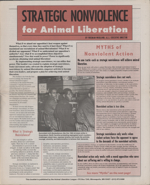
…
-
No Compromise, Periodicals
No Compromise #6-7
08.23.11 | Permalink | Comments Off on No Compromise #6-7No Compromise #6-7 (1997. Minneapolis, MN.)
The second year of No Compromise was packed with inspiring coverage of the growth of the militant grassroots, including some of the most important events of the 90s: Tony Wong’s hunger strike, the mass arrests and police riot at the Yerkes primate center, and the World Week for Animals in Laboratories arrests at the UC Davis primate center.
Tony Wong was only 16 years old when he was convicted for a civil disobedience action at the Lazurus department store. He immediately began a hungerstrike in prison, and after a month of not eating the staff at the juvenile facility where he was being held began force feeding him animal products through a tube forcefully inserted through his nose. The brutality faced by Tony acted as a lightning rod, and soon large demonstrations and acts of sabotage rippled across the country. The most important thing that Tony did though was to set an example of dedication that others could admire and aspire to in their own lives. Sadly, Tony eventually embraced a deeply speciesist political transformation and began consuming animals again after sacrificing so much to save them.
World Week in 1997 saw miniature police riots in Georgia and California. The protests themselves were not as important as the resulting boost to the movement created by the heavy handedness of the cops. As van loads of activists traveled to these demonstrations and found themselves sharing jail cells with like minded comrades, they soon formed tighter networks which led to greater revolutionary potential. The west coast and east coast both saw an upswing in regional actions after these arrests.
No Compromise was plagued by it’s usual production and distribution delays this year. It only got two issues finished, and they didn’t make it into people’s hands on the advertised cover dates, but both of these issues are wonderful documents of their era.
No Compromise #1-5 can be found here.
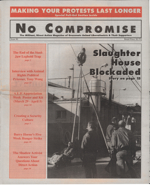
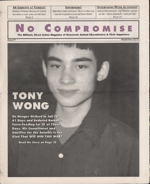
…



